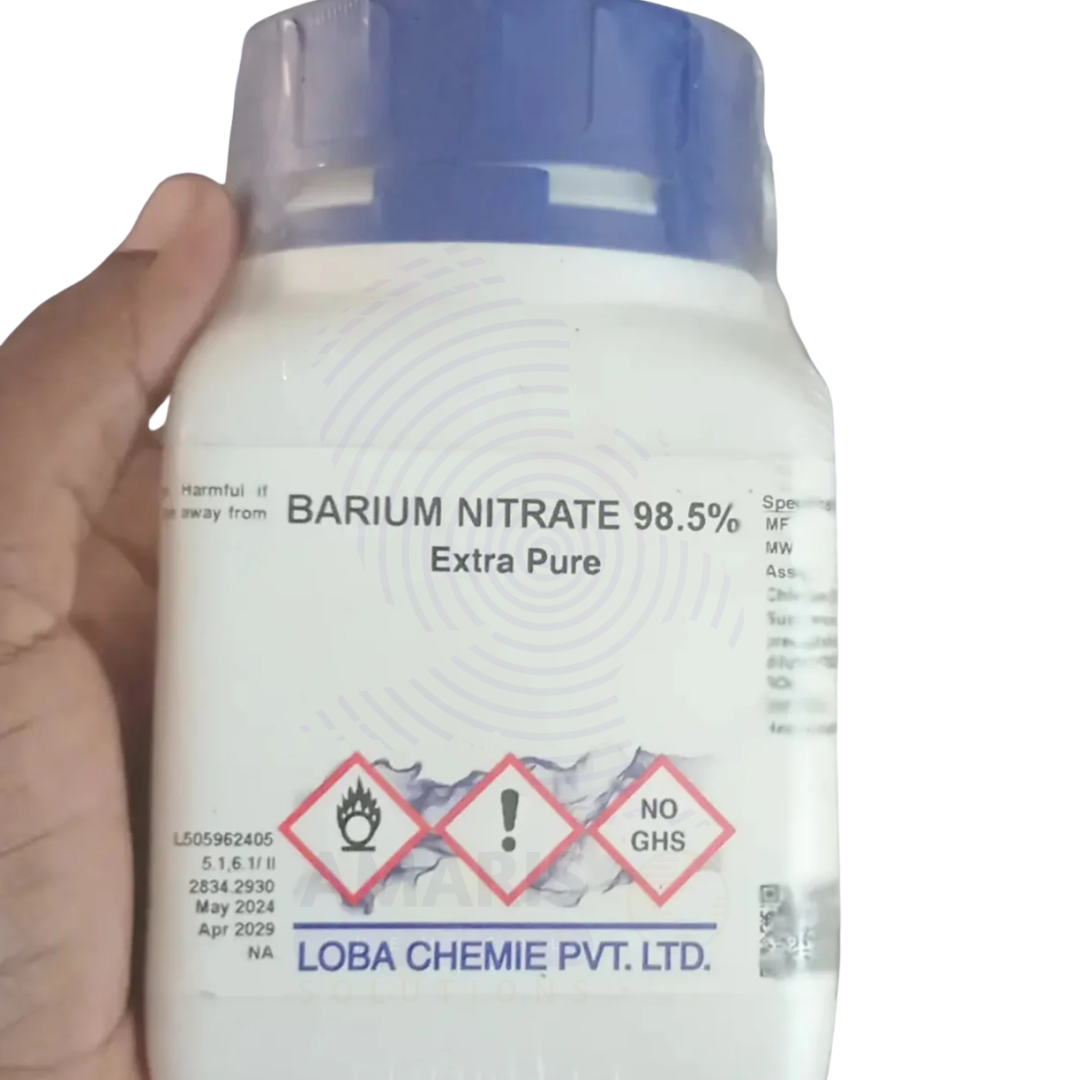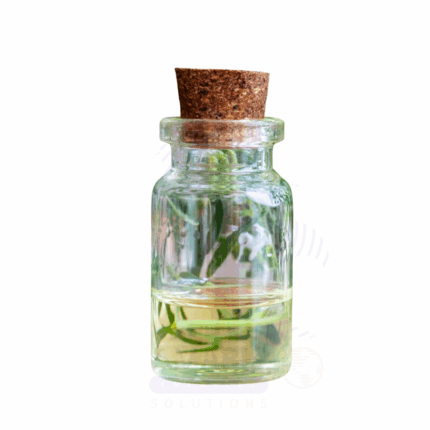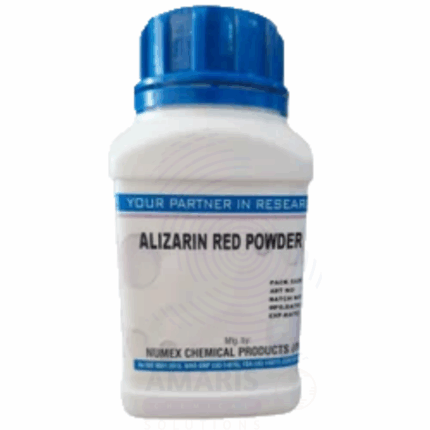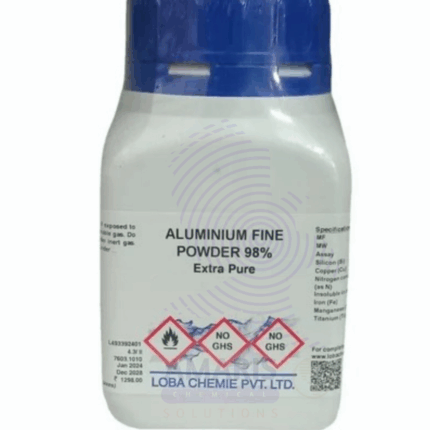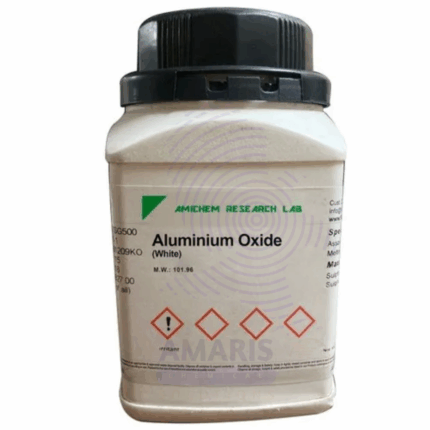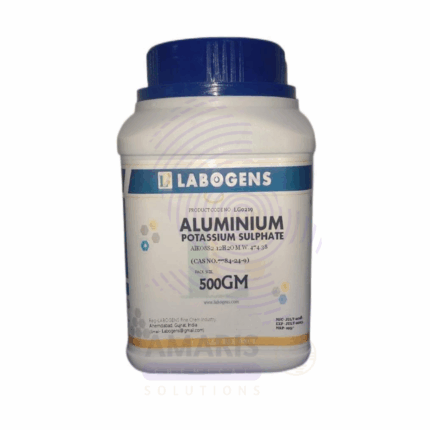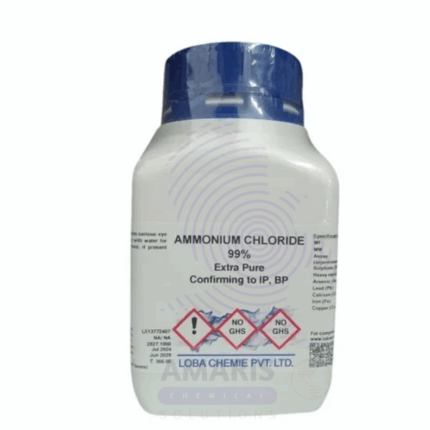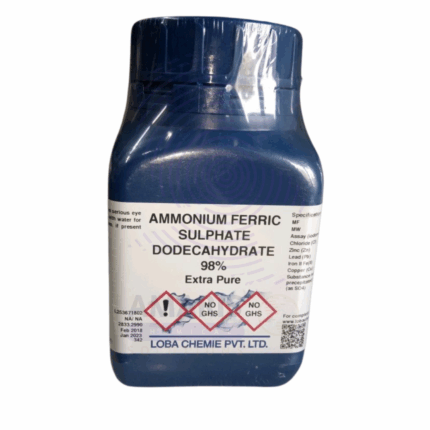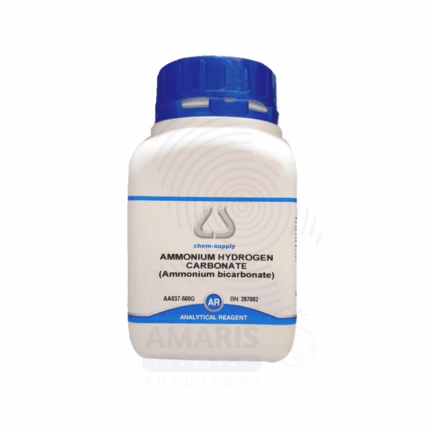Barium Nitrate Extra Pure
$ 18.00 Original price was: $ 18.00.$ 17.54Current price is: $ 17.54.
Barium Nitrate Extra Pure is a high-purity, white crystalline compound widely used in laboratory chemistry for analytical, inorganic, and combustion-related studies. As a strong oxidizing agent, it plays a key role in thermal decomposition and pyrotechnic research, producing a characteristic green flame in flame tests. It is also used in the synthesis of other barium compounds, precipitation reactions, and studies involving nitrate chemistry. The extra pure grade ensures minimal levels of impurities, making it suitable for high-precision experiments and sensitive analytical work. Due to its oxidizing nature and toxicity, it should be handled with care and stored in tightly sealed containers in a cool, dry place, away from organic materials and heat sources.
Barium Nitrate Extra Pure
Primary Uses
- Reagent in Flame Test Demonstrations
- Emits a distinctive green flame due to the presence of Ba²⁺ ions — a common demonstration in elemental identification and teaching spectroscopy.
- Oxidizing Agent in Redox Reactions
- Acts as a source of nitrate ions, facilitating oxidation reactions in inorganic chemistry labs and small-scale combustion studies.
- Precursor for Synthesis of Other Barium Compounds
- Reacts with acids or bases to yield BaCl₂, BaCO₃, BaSO₄, etc., making it a valuable starting material in salt synthesis experiments.
- Gravimetric and Volumetric Analysis
- Used in precipitation reactions to determine concentrations of sulfate, carbonate, or chromate ions by forming sparingly soluble barium salts.
- Standard Compound in Solubility Product (Ksp) Studies
- Useful for constructing solubility curves or studying precipitation equilibria, especially in multivalent anion systems.
Secondary Uses
- Pyrochemical and Propellant Research (Lab-Scale)
- Occasionally used in research on pyrotechnic mixtures and oxidizer behavior, under strictly controlled lab conditions (not for general lab use due to explosion risk).
- Source of Ba²⁺ in Coordination Chemistry
- Utilized to study complex formation, ionic radii, and stability of barium-ligand interactions in educational inorganic chemistry experiments.
- Teaching Tool in Qualitative Inorganic Analysis
- Demonstrates group 2 metal behaviors, including solubility differences, thermal decomposition, and nitrate ion analysis.
- Demonstration of Thermal Decomposition of Nitrates
- Decomposes upon heating to produce barium oxide (BaO), nitrogen dioxide (NO₂), and oxygen (O₂) — useful in kinetic and thermodynamic studies.
- Research in Glass, Ceramic & Electroceramic Chemistry
- Occasionally tested in glass formulations or Ba-based ceramic materials for dielectric and optical studies.
| PACK SIZE |
500 grams Plastic Tin |
|---|
1. Basic Identification Attributes
- Chemical Name: Barium Nitrate
- CAS Number: 10022-31-8
- HS Code: 28342990 (Other nitrates: Barium nitrate)
- Molecular Formula: Ba(NO₃)₂
- Synonyms:
- Barium dinitrate
- Nitric acid, barium salt
- Barium salt of nitric acid
2. Physical & Chemical Properties
- Physical State: Solid (crystalline powder or granules)
- Color & Odor: White; odorless
- Melting Point: 592 °C
- Boiling Point: Decomposes before boiling
- Density: ~3.24 g/cm³
- Solubility:
- Water: Soluble (~10.5 g/100 mL at 20 °C)
- Alcohol: Insoluble
- pH (aqueous solution): Neutral to slightly acidic
- Vapor Pressure: Not applicable
- Flash Point: Not flammable (oxidizer)
3. Safety & Hazard Attributes
- Hazard Class (GHS):
- Oxidizing Solid (Category 2)
- Acute Toxicity, Oral (Category 4)
- Eye Irritation (Category 2A)
- NFPA Ratings:
- Health: 2
- Flammability: 0
- Reactivity: 1 (oxidizer)
- Exposure Limits:
- OSHA PEL (as Ba): 0.5 mg/m³
- ACGIH TLV (as Ba): 0.5 mg/m³
- Reactivity:
- Strong oxidizer — may accelerate combustion
- Reacts with combustible materials and reducing agents
- Decomposes to release toxic fumes (NOₓ, BaO)
4. Storage & Handling Attributes
- Storage Conditions:
- Store in a cool, dry, well-ventilated place
- Keep away from incompatible substances (e.g., organic matter, sulfur, reducing agents)
- Incompatible Materials:
- Combustibles, acids, reducing agents, phosphorus
- Container Type:
- Use only non-metallic, tightly sealed containers
- Shelf Life:
- Stable for 3+ years if stored dry
- Special Handling:
- Wear protective gloves, goggles, lab coat
- Handle in fume hood; avoid inhaling dust
5. Regulatory & Compliance Attributes
- Transportation Information:
- UN Number: UN1446
- Class: 5.1 (Oxidizing substance)
- Packing Group: II
- Waste Disposal:
- Dispose of as hazardous waste
- Avoid release into drains or environment
- Regulations:
- Listed under TSCA, REACH, IATA, and IMDG
- Regulated due to oxidizing and toxic properties
6. Environmental & Health Impact
- Ecotoxicity:
- Toxic to aquatic life due to barium ion toxicity
- Biodegradability:
- Inorganic compound — not biodegradable
- Carcinogenicity:
- Not classified as carcinogenic
- Bioaccumulation Potential:
- Low in humans, but soluble barium compounds are hazardous
SAFETY PRECAUTIONS
- Personal Protective Equipment (PPE):
- Wear a lab coat, chemical-resistant gloves (e.g., nitrile), and safety goggles.
- Use a fume hood during weighing, transfer, or heating.
- Handling:
- Avoid contact with skin, eyes, and clothing.
- Do not inhale dust—it is toxic and irritating to the respiratory system.
- Keep away from organic materials, combustibles, and reducing agents—oxidizers.
- Storage:
- Store in a cool, dry, and well-ventilated area.
- Keep the container tightly sealed and away from flammable materials.
- Store separately from acids and organics.
- Hygiene Measures:
- Wash hands thoroughly after handling.
- Avoid any ingestion or cross-contamination with food and drinks in lab.
FIRST AID MEASURES
- Inhalation:
- Move the person to fresh air.
- Seek medical attention if irritation, coughing, or shortness of breath occurs.
- Skin Contact:
- Wash immediately with plenty of water.
- Remove contaminated clothing and rinse affected area.
- Seek medical help if irritation or pain persists.
- Eye Contact:
- Rinse thoroughly with copious water for at least 15 minutes.
- Seek immediate medical attention.
- Ingestion:
- Do not induce vomiting.
- Rinse mouth and give water if the person is conscious.
- Seek emergency medical attention — barium compounds are highly toxic when ingested.
FIRE FIGHTING MEASURES
- Extinguishing Media:
- Use water spray, CO₂, dry chemical, or foam.
- Avoid using dry combustibles near this oxidizer.
- Fire Hazards:
- Not combustible itself, but supports combustion of other materials.
- Decomposes on heating to release:
- Barium oxide (BaO)
- Nitrogen oxides (NOₓ)
- Protective Equipment:
- Firefighters must wear self-contained breathing apparatus (SCBA) and full protective gear.
- Firefighting Instructions:
- Cool containers with water spray.
- Avoid runoff entering water systems—barium compounds are toxic to aquatic life.


 Preservatives(food)
Preservatives(food) Flavor Enhancers
Flavor Enhancers Acidulants
Acidulants Sweeteners
Sweeteners Antioxidants
Antioxidants Colorants(food)
Colorants(food) Nutraceutical Ingredients (food)
Nutraceutical Ingredients (food) Nutrient Supplements
Nutrient Supplements Emulsifiers
Emulsifiers
 Collectors
Collectors Dust Suppressants
Dust Suppressants Explosives and Blasting Agents
Explosives and Blasting Agents Flocculants and Coagulants
Flocculants and Coagulants Frothers
Frothers Leaching Agents
Leaching Agents pH Modifiers
pH Modifiers Precious Metal Extraction Agents
Precious Metal Extraction Agents
 Antioxidants(plastic)
Antioxidants(plastic) Colorants (Pigments, Dyes)
Colorants (Pigments, Dyes) Fillers and Reinforcements
Fillers and Reinforcements Flame Retardants
Flame Retardants Monomers
Monomers Plasticizers
Plasticizers Polymerization Initiators
Polymerization Initiators Stabilizers (UV, Heat)
Stabilizers (UV, Heat)
 Antifoaming Agents
Antifoaming Agents Chelating Agents
Chelating Agents Coagulants and Flocculants
Coagulants and Flocculants Corrosion Inhibitors
Corrosion Inhibitors Disinfectants and Biocides
Disinfectants and Biocides Oxidizing Agents
Oxidizing Agents pH Adjusters
pH Adjusters Scale Inhibitors( water)
Scale Inhibitors( water)
 Antioxidants(cosmetic)
Antioxidants(cosmetic) Emollients
Emollients Fragrances and Essential Oils
Fragrances and Essential Oils Humectants
Humectants Preservatives
Preservatives Surfactants(cosmetic)
Surfactants(cosmetic) Thickeners
Thickeners UV Filters
UV Filters
 Fertilizers
Fertilizers Soil Conditioners
Soil Conditioners Plant Growth Regulators
Plant Growth Regulators Animal Feed Additives
Animal Feed Additives Biostimulants
Biostimulants Pesticides (Herbicides, Insecticides, Fungicides)
Pesticides (Herbicides, Insecticides, Fungicides)
 Active Pharmaceutical Ingredients (APIs)
Active Pharmaceutical Ingredients (APIs) Excipients
Excipients Solvents(pharmaceutical)
Solvents(pharmaceutical) Antibiotics
Antibiotics Antiseptics and Disinfectants
Antiseptics and Disinfectants Vaccine Adjuvants
Vaccine Adjuvants Nutraceutical Ingredients (pharmaceutical)
Nutraceutical Ingredients (pharmaceutical) Analgesics & Antipyretics
Analgesics & Antipyretics
 Analytical Reagents
Analytical Reagents Solvents(lab)
Solvents(lab) Chromatography Chemicals
Chromatography Chemicals Spectroscopy Reagents
Spectroscopy Reagents microbiology-and-cell-culture-reagents
microbiology-and-cell-culture-reagents Molecular Biology Reagents
Molecular Biology Reagents Biochemical Reagents
Biochemical Reagents Inorganic and Organic Standards
Inorganic and Organic Standards Laboratory Safety Chemicals
Laboratory Safety Chemicals Specialty Laboratory Chemicals(Special Laboratory Equipment)
Specialty Laboratory Chemicals(Special Laboratory Equipment)
 Demulsifiers
Demulsifiers Hydraulic Fracturing Fluids
Hydraulic Fracturing Fluids Scale Inhibitors(oil)
Scale Inhibitors(oil) Surfactants(oil)
Surfactants(oil) Drilling Fluids
Drilling Fluids
 Dyes and Pigments
Dyes and Pigments Bleaching Agents
Bleaching Agents Softening Agents
Softening Agents Finishing Agents
Finishing Agents Antistatic Agents
Antistatic Agents
 Admixtures
Admixtures Waterproofing Agents
Waterproofing Agents Sealants and Adhesives
Sealants and Adhesives Curing Compounds
Curing Compounds Concrete Repair Chemicals
Concrete Repair Chemicals Anti-Corrosion Coatings
Anti-Corrosion Coatings
 Surfactants(cleaning)
Surfactants(cleaning) Builders
Builders Enzymes
Enzymes Solvents (Cleaning)
Solvents (Cleaning) Fragrances
Fragrances
 Electronic Chemicals
Electronic Chemicals Catalysts
Catalysts Lubricants
Lubricants Photographic Chemicals
Photographic Chemicals Refrigerants
Refrigerants Automotive chemicals
Automotive chemicals Pyrotechnic Chemicals
Pyrotechnic Chemicals
 Biodegradable Surfactants
Biodegradable Surfactants Bio-based Solvents
Bio-based Solvents Renewable Polymers
Renewable Polymers Carbon Capture Chemicals
Carbon Capture Chemicals Wastewater Treatment Chemicals
Wastewater Treatment Chemicals
 Pigments
Pigments Solvents(paint)
Solvents(paint) Specialty Coatings
Specialty Coatings Binders/Resins
Binders/Resins Additives
Additives Driers
Driers Anti-Corrosion Agents
Anti-Corrosion Agents Functional Coatings
Functional Coatings Application-Specific Coatings
Application-Specific Coatings
 Fresh Herbs
Fresh Herbs Ground Spices
Ground Spices Whole Spices
Whole Spices Spice Blends
Spice Blends Dried Herbs
Dried Herbs
 Leavening Agents
Leavening Agents Dough Conditioners
Dough Conditioners Flour Treatments
Flour Treatments Fat Replacers
Fat Replacers Decoratives
Decoratives Preservatives(baking)
Preservatives(baking)
 Plasticizers & Softeners
Plasticizers & Softeners Reinforcing Agents
Reinforcing Agents Adhesion Promoters
Adhesion Promoters Vulcanizing Agents
Vulcanizing Agents Antidegradants
Antidegradants Blowing Agents
Blowing Agents Fillers & Extenders
Fillers & Extenders Accelerators & Retarders
Accelerators & Retarders